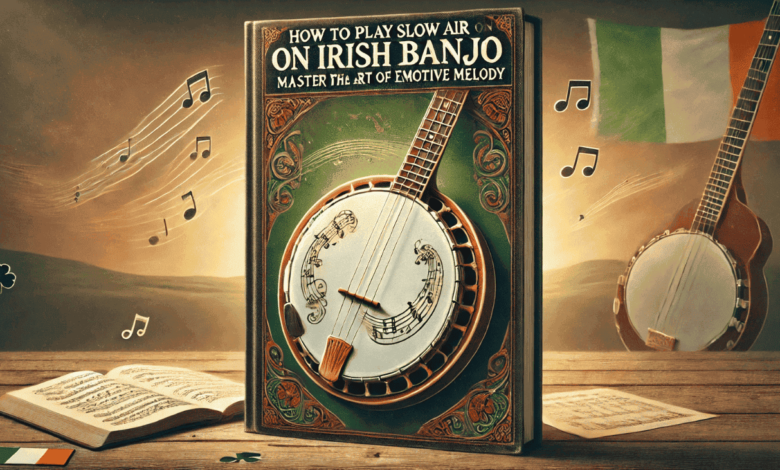How to Play Slow Air on Irish Banjo: Master the Art of Emotive Melody

Playing slow airs on the Irish banjo can be a beautiful and rewarding experience. These expressive, often melancholic tunes require a careful balance of delicate ornamentation and tone control. Unlike faster jigs or reels, slow airs demand a deeper emotional connection to the music. But how do you capture the essence of a slow air on the banjo, a bright, percussive instrument known for its rhythmic sound? In this guide, we’ll show you how to play slow air on Irish banjo by focusing on key techniques, helpful tips, and the right mindset.
Why Playing Slow Airs on the Irish Banjo is Challenging
The Irish banjo is often associated with lively rhythms and fast-paced tunes, but it’s capable of so much more, especially when playing slow airs. Slow airs are unique in their emotional depth, requiring a level of nuance that is different from the typical upbeat tunes played on the banjo. Understanding how to play slow air on Irish banjo involves not just technical proficiency but also the ability to bring out the emotive quality that makes these pieces so special.
Let’s explore how you can bring your banjo playing to new heights with these gentle and evocative melodies.
Embrace Ornamentation to Enhance Your Playing
Mastering Ornamentation for Expressiveness
When learning how to play slow air on Irish banjo, it’s crucial to understand the role of ornamentation. Irish slow airs are often embellished with grace notes, rolls, and triplets, which help inject personality and fluidity into the performance. These ornaments are essential for expressing the emotional subtleties of the air.
Grace notes—quick, ornamental notes—are a fantastic way to decorate the melody. Start by adding them subtly, just before or after the main note, to create a more flowing and dynamic performance. Triplets and rolls are other important techniques to practice as they help smooth transitions between notes, giving the air a connected, almost lyrical quality.
Why Ornamentation is Essential for Slow Airs
Without ornamentation, slow airs can sound stiff or mechanical. To play them on the banjo in a way that mirrors their intended expressiveness, you’ll need to focus on adding small, delicate flourishes that make the air feel more like a conversation rather than a rigid, note-for-note performance.
Focus on Tone and Dynamics
Creating the Right Tone on the Banjo
Playing slow air on Irish banjo requires a keen focus on tone and dynamics. Unlike other instruments, the banjo tends to have a sharp and bright tone that can make slow airs sound overly harsh if not handled carefully. Start by paying attention to your attack—aim for a gentle, controlled strike on the strings with your pick. This will help you produce a softer, more nuanced sound.
Use Dynamics to Add Emotion
Slow airs are all about emotion, and dynamic control is the key to bringing that emotion to life. Work on varying your volume throughout the piece. For example, you could gradually increase the volume during the more intense phrases, then pull back for a quieter, more contemplative section. This ebb and flow of dynamics will add richness and emotional depth to your performance.
Learn from Traditional Irish Music
Study Slow Airs on Other Instruments
While the Irish banjo might not be the traditional instrument for slow airs, you can still draw valuable insights from other instruments commonly used in Irish music, such as the uilleann pipes or fiddle. These instruments are masters at delivering the emotive phrasing and ornamentation typical of slow airs.
Listen closely to recordings of famous slow airs played on these instruments, paying special attention to the phrasing, ornamentation, and dynamics. Try transcribing the melody and adapting it to your banjo. This will give you a deeper understanding of how to play slow air on Irish banjo while staying true to its musical roots.
Choose the Right Repertoire
Start with Simple Slow Airs
When learning how to play slow air on Irish banjo, it’s essential to start with the right repertoire. Begin with simple, well-known slow airs that are easy to adapt to the banjo. A good place to start is with airs like “Inisheer” or “The Derry Air,” which are not overly complex but still full of emotional depth.
These pieces are particularly well-suited to the Irish banjo, offering a perfect balance of challenge and playability. Once you’ve mastered them, you can begin tackling more complex airs that require a greater level of ornamentation and dynamic control.
Practice at a Slow Tempo
The Importance of Slow Practice
One of the most important tips when learning how to play slow air on Irish banjo is to practice at a slower tempo. Slow airs require precision and careful attention to detail. Playing too quickly can diminish the emotional impact of the piece and prevent you from fully mastering the nuances of the melody.
Start by practicing the air at a slow pace, ensuring that every note is clean and well-phrased. Focus on your tone, ornamentation, and dynamics. As you grow more comfortable, you can gradually increase the tempo without sacrificing the emotional depth of the piece.
Seek Feedback from Experienced Players
Learn from the Banjo Community
Finally, when you’re learning how to play slow air on Irish banjo, seek feedback from other banjo players or musicians experienced in traditional Irish music. Joining communities like The Session or Banjo Hangout allows you to engage with fellow musicians and get valuable advice. Whether it’s through online lessons or in-person sessions, learning from others is a great way to improve your technique and expand your repertoire.
FAQ: How to Play Slow Air on Irish Banjo
What is the best slow air to start with on Irish banjo?
Start with simple, well-known airs like “Inisheer” or “The Derry Air.” These are not too complex, yet they provide a solid foundation for learning ornamentation and phrasing.
How do I control the dynamics when playing slow airs?
To control dynamics, practice varying the volume gradually. Use crescendos and decrescendos to emphasize the emotional highs and lows of the air.
Do I need to use ornamentation when playing slow airs on the banjo?
Yes, ornamentation is essential for capturing the expressive nature of slow airs. Incorporating grace notes, rolls, and triplets will help give your performance more fluidity and emotional depth.
How can I avoid my banjo sounding too sharp when playing slow airs?
Focus on soft, controlled strikes on the strings, using a gentle pick attack. This will help reduce the sharpness and create a smoother, warmer tone.
Conclusion
Learning how to play slow air on Irish banjo is a journey that combines technical skills with deep emotional expression. With practice, you’ll master the art of ornamentation, tone control, and dynamics, enabling you to bring these hauntingly beautiful melodies to life. Start with simple tunes, focus on ornamenting each phrase, and don’t forget to slow down your practice to get the best results. Over time, you’ll find yourself playing slow airs with the depth and richness that these tunes deserve.
By following these tips and continuously honing your craft, you can unlock the true beauty of slow airs on the Irish banjo. Happy playing!



